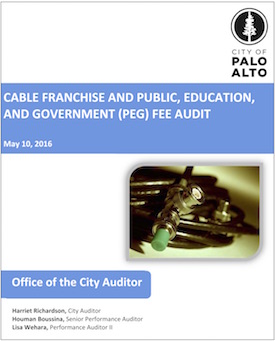
Click for the full story.
California cities and counties don’t have much to say about the service cable companies provide and the prices they charge for it. When the state took control of cable franchises with the 2006 Digital Infrastructure and Video Competition Act (DIVCA), local governments were largely pushed out of the regulatory picture.
But not completely. Cities can still collect a franchise fee of up to 5% of gross video revenue and another 1% to pay capital equipment costs for public access channels. They also have the ability to take cable companies to court if there’s a dispute over whether all service and financial obligations are being met.
The City of Palo Alto recently did a thorough audit of the franchise and public access channel fees it was collecting from Comcast and AT&T and found problems on both sides of the table. Palo Alto manages video fee collection on behalf of several other Peninsula communities, and contracts with the Midpeninsula Community Media Center to run the region’s public access channels. The video fee money it passed along wasn’t spent legally, however, according to the auditor’s report…
The Media Center inappropriately used an annual average of $340,000 of public, education, and government (PEG) fees, or $1.4 million during the audit period, paid by cable television subscribers in the Cable Joint Powers areas, for operating expenses. Neither the City nor the Media Center enforced the federal law that restricts the use of PEG fees to capital expenses associated with PEG access facilities.
On the other hand, AT&T and Comcast were shortchanging the cities…
Comcast and AT&T did not always calculate the fees due in accordance with DIVCA and the municipal code of each of the Cable Joint Powers. As a result, Comcast underpaid about $141,000 in franchise and PEG fees from July 1, 2010, through June 30, 2014, and AT&T underpaid about $76,000 from July 1, 2011, through September 30, 2014.
The auditor’s recommendations can be generally summed up as pay more attention to what the companies, the Media Center and you, the city, are doing.
Not many California cities take as much interest as Palo Alto in exercising what little remaining video franchise authority remains, but the auditor’s report, which includes a lengthy rebuttal from the Media Center, is a good template to use if any want to up their game.
